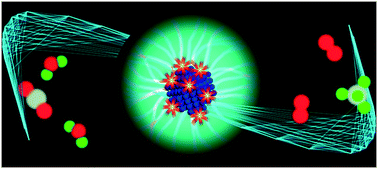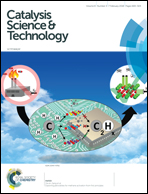Bringing attention to metal (un)availability in encapsulated catalysts†
Abstract
The study focuses on the determination of metal site availability in silica-encapsulated Pd catalysts (Pd@SiO2). Existing synthetic methods are modified to achieve a high metal loading (up to 6 wt%) and porosity (surface area of 700 m2 g−1) while maintaining the original Pd nanoparticle size of 8 nm. Two synthesis schemes are used for encapsulating Pd NPs, and the resulting catalysts are assessed in lean methane combustion at up to 823 K. Application of poly(vinylpyrrolidone) (PVP) as a Pd particle stabilizer and a potential porogen alone is concluded to be inadvisable as it results in catalysts with a surface area of 70 m2 g−1 that show extremely low activity due to Pd inaccessibility. The high-surface area materials (700 m2 g−1) prepared via a separate introduction of PVP and an additional porogen (cetyltrimethylammonium bromide, CTAB) are active and exhibit the same turnover frequencies as the traditional catalysts but require smaller reactor sizes because of the high metal loading. However, 2/3 of the Pd nanoparticle surface is blocked by the shell material even in the highly porous catalysts. The silica-encapsulated catalysts, thus, offer advantages of high mass-based activity and sintering resistance of the metal cores, but their high porosity must be ensured for efficient mass transfer by the addition of a porogen (such as CTAB) during the Stöber process. Above a certain limit, the increased amount of the porogen does not improve the metal accessibility and only leads to precious metal loss during synthesis.



 Please wait while we load your content...
Please wait while we load your content...